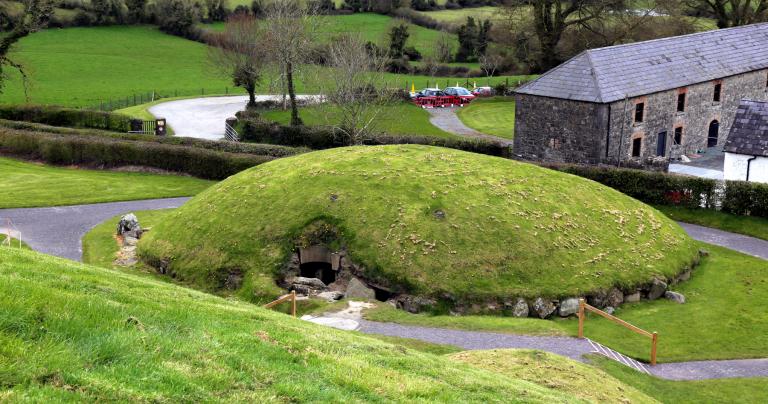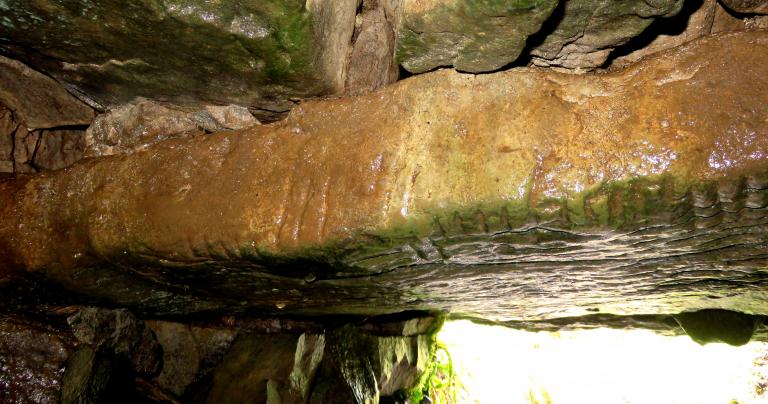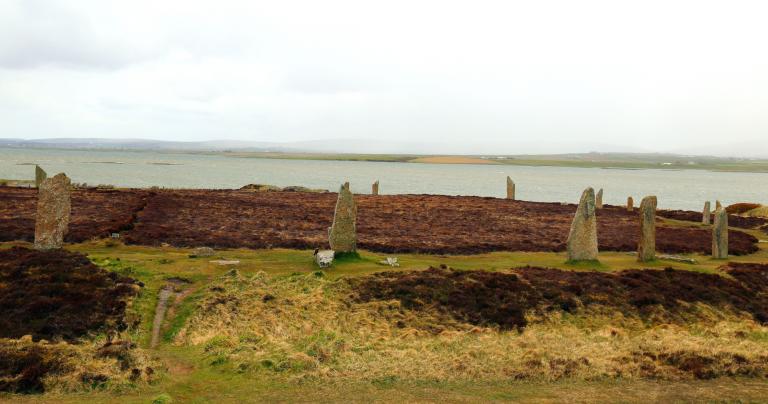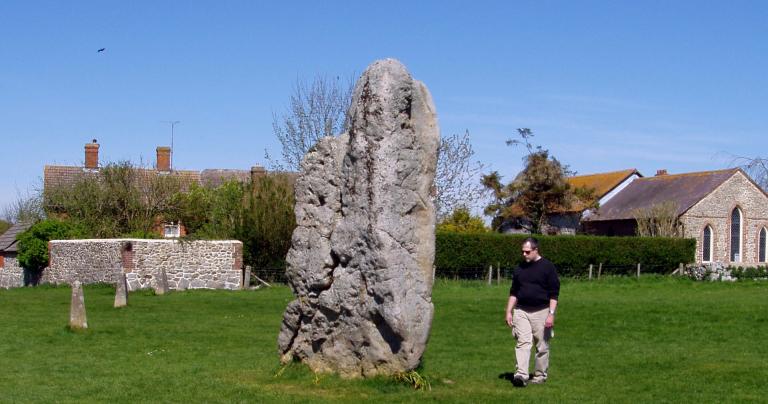One of the questions for last month’s Conversations Under the Oaks dealt with a pilgrimage to Ireland and asked for recommendations for places to visit. Most of the places I can recommend are well-known. I’ve blogged about them – use the search block at the right to find them. If you need professional help contact Lora O’Brien or Land Sea Sky Travel.
Most of my trips have at least an element of pilgrimage in them. So in this post, I’m going to talk about the process of pilgrimage: what it is, what it isn’t, and especially how we prepare for pilgrimage.

What is pilgrimage?
The Catholic Encyclopedia says that pilgrimages are “journeys made to some place with the purpose of venerating it, or in order to ask there for supernatural aid, or to discharge some religious obligation.” I think that definition is a good start. It’s a journey, made for religious reasons, to do something religiously motivated. Simply visiting a religious site is not a pilgrimage. My visit to Stonehenge in 2007 was not a pilgrimage. I had Pagan reasons for wanting to see Stonehenge, but that visit was for curiosity rather than to do anything significant while I was there.
My visits to Anglesey in 2014, to Orkney in 2016, and to Rathcroghan in 2018 were all pilgrimages. So was a day trip to a National Forest in 2017. It is the motivation behind the journey and our actions while we’re there that make a trip a pilgrimage.
What calls you to pilgrimage?
So your first question is what – or who – is calling you to pilgrimage? Why do you need to go here and not there? What are you supposed to do when you get there?
You may not be able to come up with precise answers to those questions. That’s OK. Many calls to pilgrimage are rather vague and leave you with the impression that you won’t know until you get there. I had no idea what I was supposed to do on my Orkney pilgrimage until I reached the Ring of Brodgar.
The main thing is to insure that the motivation for your trip is religious (whatever that means for you), and that you understand you’re going there to do something, not just to see the sights.
Investigation and research
I know some people who like to walk into new places “cold.” They want to minimize their expectations and take it all in for the first time in person. I don’t agree. When you walk into a place knowing virtually nothing about it, you’re naturally going to be drawn to the mundane sights: a beautiful gothic cathedral, a massive standing stone, or a majestic forest. It’s good to appreciate the ordinary beauty of a place, but that’s not the purpose of a pilgrimage.
Instead, do some research on the places you’re going. Find out where they are and how you’ll get there. Draw from the experiences of previous travelers: what’s going to grab your attention? If you’re prepared for it, you can notice it and appreciate it, but remain focused on your spiritual goal. Also, what details are important to you that may get left off mainstream tours? What’s nearby that tourists ignore that would be deeply meaningful to you? If you wait till you’re there, you’ll miss these details.
Finally, doing research helps you orient yourself once you get there. The easier and more reliably you can acquaint yourself with the layout of the place, the sooner you can start opening yourself to deeper currents.

Meditation and offerings
There’s a lot of work to do in planning any trip, much less a pilgrimage. And the closer you get, the more the anticipation builds. It’s important to stay grounded and to stay focused on the primary goal of your pilgrimage.
If you don’t already have a meditation practice, start one. If you already have one, increase the frequency or duration or both of your sessions. Keep your sacred mission firmly in your mind.
Make special offerings. Maintain your normal offerings to your Gods and ancestors. Consider increasing your offerings to your local land spirits – they’ll have to look after things while you’re gone. Make offerings to deities who facilitate travel. And if the focus of your pilgrimage deals with a particular deity, be sure to make regular offerings to Them before you leave.
Seek out native guides and listen to them
As you’re planning your trip, seek out local people with relevant expertise. Anglesey is a powerful place, but I could not have gotten a fraction of what I did out of my trips there without the guidance of Kristoffer Hughes.
Your guides don’t have to be Pagan to be of assistance, though that certainly helps. Most of the drivers and guides I’ve encountered in Ireland have been Catholic, but they’ve shown me things about their land and its lore than I never could have gotten from a book, or even from an experienced American tourist. Daniel Curley, our guide at Rathcroghan, knew I was a Druid – he made sure to point out the Ogham carvings on lintel stone at Oweynagat. I never would have noticed them without him.
Seek out the local experts, and pay attention to what they tell you.

Traveling is part of the pilgrimage
In ancient times, pilgrimages were done on foot, or if you were wealthy, on horseback. A local pilgrimage (such as those described in Canterbury Tales) could take a week or two. A pilgrimage to Jerusalem could take several years.
Today you can get on an airplane and in a few hours be in any country in the world. It’s easy to forget that the travels are supposed to be part of the pilgrimage. TSA screenings hardly compare to encountering brigands on the highway. Still, remember that travel inconveniences and disruptions are part of the overall experience. Select your travel reading material accordingly.
Make introductions
When you get to where ever it is you’re going, your first job is to introduce yourself. I like to pour offerings of clean water to the spirits of the land where I am, tell them who I am and what I’m doing, and ask for their blessing (or at least, their permission) for the travels.
For holy sites, larger offerings may be required. We poured whiskey at multiple sites on our most recent trip to Ireland.
Listen
There is a certain feeling of triumph when after months of planning and days of travel, you finally reach Brodgar or Newgrange or the redwoods of California. You’re finally here, and it’s everything you thought it would be and more. The urge to scream with delight may be overwhelming.
Remember you are guest in a strange land. Remember you were called here for some sacred purpose. It’s OK to enjoy yourself, and it’s OK to feel a sense of accomplishment, but your deepest work is only beginning.
Stop.
Listen.
Listen for the spirits of the place. Listen for the deity or deities who called you there. Listen to the land itself.
Listen.
What do you hear? Are you OK to proceed? Or do you need to make additional offerings or perform additional preparatory rituals?
Listen.

Do what you came to do
Now you’re ready to begin your prayers, meditations, offerings, circumambulations, communions, rituals, or whatever it is you came here to do.
If you came here not knowing exactly why, now’s the time to figure it out. Perhaps you’ll be told. Perhaps you’ll need to start into your work and feel your way through it. Perhaps something totally unexpected will happen. Or perhaps not.
Be open to whatever you hear, even if it strikes you as odd or unusual. Sacred sites and the spirits who inhabit them are older and wiser than you. Listen to them.
And be open to having your plans turned upside down. I knew I was supposed to visit the stone circle at Lough Gur. I had no idea what I was supposed to do there. I certainly had no idea I’d have to do it in a cold, driving, rainstorm.
If you must do one thing, do that one thing no matter how difficult it is. If you are pulled in another direction, go in that direction. I cannot tell you how to differentiate between a hardship that must be overcome and a detour sign telling you to do something different, except to say I’ve always known the difference when it’s happened to me. When it doubt, listen.
This is the culmination of your pilgrimage. It is not the end.

Give thanks
You should, of course, be giving thanks regularly throughout your preparations and your journey. We are not entitled to travel, to the assistance of experts and guides, or to wonderful experiences. That we have them anyway is cause for thanksgiving.
But completion of your primary goal is cause for special thanksgiving: to the place and the spirits of the place. To the Gods and spirits who called you there, and who facilitated your travels. To the ancestors who made your pilgrimage possible.
And also, to your traveling companions, your local guides, and to all the other people who helped you get to where you are and helped you do what you needed to do.
Like so much in life, pilgrimage is a solitary pursuit, but it is never done alone. Your success is never entirely your own. Give thanks where it is due.
Allow yourself to vacation a bit… unless you can’t
None of my pilgrimages have been all business. They’ve included mundane sightseeing, exploring local food and drink, and in one case, closing down a Dublin pub. Particularly if you are on a long, overseas (i.e. – expensive) trip, make as much of it as you can. Don’t let playing tourist get in the way of your sacred work, but once that work is done (or perhaps, before it can begin) have some fun.
Unless, of course, you can’t. You may receive instructions to spend the entire trip in meditation and prayer. If so, you’ll know it. Again, listen – and pay attention to what you hear.
The journey back is part of the pilgrimage
The pilgrimage is not complete until you return home. There may be more to experience and more to learn on your return trip.
The journey home is a good time to begin contemplating your experience. Record your observations as soon after they happen as you can – memories fade quickly. What happened? What did you see and hear and feel? How did it compare with your expectations?
What did you learn?
What do you think it means?
Incorporate it into your practice
Even when they turn out to be arduous, pilgrimages are some of the most rewarding sacred traditions we can participate in. But the purpose of a pilgrimage isn’t to give you a peak experience. It’s to do or show or teach or facilitate something in your life so you come home more than when you left.
How can you incorporate that more into your daily spiritual practice? Into your regular acts of service and devotion? Into your regular studies? Into your mundane life?
One of the benefits of travel is that it never really ends. It continues in photographs, souvenirs, and especially in memories. I spent perhaps an hour at the Ring of Brodgar in 2016 – I’ve spent many hours there ever since.
Travel is good in and of itself. Pilgrimage is sacred travel, for a sacred purpose. If you are called to pilgrimage, I strongly encourage you to say yes.

















